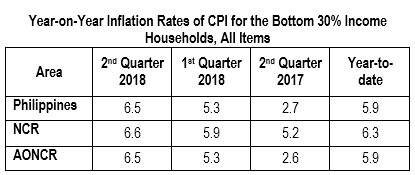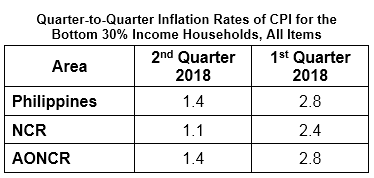SECOND QUARTER 2018
YEAR-ON-YEAR
Philippines

The country’s year-on-year inflation for the bottom 30% income households went up by 6.5 percent in the second quarter of 2018. This was higher than the 5.3 percent annual increase in the first quarter of 2018 and 2.7 percent in the second quarter of the previous year. The indices of all the commodity groups posted higher annual rates during the quarter (see Tables 7 and 12).
The annual increment of the food alone index at the national level picked up by 6.2 percent in the second quarter of 2018. Its annual rate was recorded at 5.3 percent in the previous quarter and 2.7 percent during the same period in 2017 (see Table 17).
The index of corn exhibited a double-digit annual gain of 10.8 percent this quarter. Relative to the annual increments in the previous quarter, higher annual mark-ups were also observed in the indices of the following food groups during the quarter:
- Rice (4.9%);
- Cereal preparations (2.3%);
- Dairy products (2.1%);
- Fruits and vegetables (7.5%); and
- Miscellaneous foods (2.0%).
On the other hand, the annual increments in the indices of fish and meat slowed down to 11.1 percent and 6.4 percent, respectively. The annual movement of eggs index remained at 2.1 percent this quarter (see Tables 15 and 17).
| Year-on-Year Inflation Rates in the Philippines, All Items 1st Quarter 2009 - 2nd Quarter 2018 | ||||||||||
|---|---|---|---|---|---|---|---|---|---|---|
| Quarter | Year | |||||||||
| 2009 | 2010 | 2011 | 2012 | 2013 | 2014 | 2015 | 2016 | 2017 | 2018 | |
| 1st | 12.4 | 4.2 | 4.6 | 2.7 | 3.5 | 5.7 | 3.1 | 1.1 | 2.8 | 5.3 |
| 2nd | 5.4 | 3.5 | 5.4 | 2.4 | 3.1 | 6.5 | 2.0 | 1.2 | 2.7 | 6.5 |
| 3rd | 0.2 | 3.7 | 5.2 | 3.1 | 3.5 | 6.8 | 0.4 | 1.4 | 3.0 | |
| 4th | 3.4 | 3.1 | 5.2 | 3.0 | 4.8 | 5.1 | 0.8 | 1.9 | 3.4 | |
| Average | 5.4 | 3.7 | 5.1 | 2.9 | 3.7 | 6.0 | 1.6 | 1.4 | 3.0 | |
National Capital Region (NCR)
Compared to a year ago level, prices for this particular group of consumers in NCR accelerated by 6.6 percent in the second quarter of 2018. In the previous quarter, inflation settled to 5.9 percent, while in the second quarter of 2017, the annual rate was observed at 5.2 percent. The growth was primarily brought about by higher annual increase noted in the heavily-weighted food, beverages and tobacco (FBT) index at 6.6 percent. Among commodity groups, the index of fuel, light and water (FLW) exhibited a double-digit annual hike of 13.7 percent during the quarter. The indices of the other commodity groups posted lower annual inflation this quarter compared to the previous quarter, with the index of housing and repairs (H&R) retaining its previous quarter’s annual rate of 2.4 percent (see Tables 8 and 12).
A higher annual mark-up of 5.8 percent was registered in the food alone index in the area during the second quarter of 2018. Its annual rate in the previous quarter was pegged at 5.4 percent and in the second quarter of 2017, 5.1 percent (see Table 18).
Relative to the annual increment in the previous quarter, higher annual upticks in the indices of the following food groups were recorded during the second quarter of 2018:
- Rice (3.0%);
- Fish (13.3%);
- Fruits and vegetables (7.6%); and
- Miscellaneous foods (9.0%).
On the other hand, slower annual rates were observed in the indices of corn at 0.4 percent; cereal preparations, 1.9 percent; and meat, 2.9 percent. The index of dairy products retained its previous quarter’s growth of 4.3 percent, while the annual adjustment of eggs index further declined as it exhibited a negative annual rate of -5.2 percent this quarter (see Tables 15 and 18).
Areas Outside NCR (AONCR)
Annual inflation in AONCR for the bottom 30% income households picked up by 6.5 percent during the second quarter of 2018. In the previous quarter, annual inflation was posted at 5.3 percent and in the second quarter of 2017, 2.6 percent. Compared from their rates in the previous quarter, all the commodity groups registered higher annual increases during the second quarter of 2018 (see Tables 9 and 12):
In the second quarter of 2018, higher annual add-ons were observed in all regions relative to their annual increases in the previous quarter. The highest annual growth was posted in Region XI (Davao Region) at 8.0 percent, while the lowest remained in MIMAROPA Region at 4.0 percent (see Table 12).
Annual inflation of the food alone index in AONCR rose by 6.2 percent in the second quarter of 2018. In the previous quarter, the annual rate picked up by 5.3 percent and in the second quarter of 2017, 2.7 percent (see Table 19).
All the food groups recorded higher annual upticks during the quarter, except for the indices of fish and meat which exhibited slower annual gains.
QUARTER-ON-QUARTER

The quarter-on-quarter inflation of the consumer prices for the bottom 30% income households at the national level slowed down to 1.4 percent during the second quarter of 2018. A higher quarterly rate of 2.8 percent was noted in the first quarter. Except for services and miscellaneous indices, all the commodity groups recorded slower quarterly increases during the period. While the services index registered a higher quarterly mark-up of 0.7 percent, the miscellaneous index retained its previous quarter’s rate of 0.4 percent (see Tables 4 and 11) .
In NCR, prices of consumer items for the bottom 30% income households registered a quarter-on-quarter growth of 1.1 percent during the period. This was lower than its previous quarter’s rate of 2.4 percent. Slower quarterly increments were noted in the indices of FBT at 0.8 percent; services, 0.2 percent; and miscellaneous, 0.6 percent. The rest of the commodity groups either retained their previous quarter’s rate or had less than 0.05 percent growth (see Tables 5 and 11).
For AONCR, the quarterly growth of the consumer prices for this income group eased to 1.4 percent in the second quarter of 2018. In the previous quarter, its rate was posted at 2.8 percent. Relative to the previous quarter, increases decelerated in the indices of FBT at 1.6 percent; clothing, 0.5 percent; H&R, 0.7 percent; and FLW, 2.3 percent. On the other hand, a higher quarterly add-on of 0.7 percent was seen in services index, while movement in miscellaneous index remained at 0.4 percent (see Tables 6 and 11).
Compared to the previous quarter, all regions exhibited lower gains during the second quarter of 2018. Region II (Cagayan Valley) and Region III (Central Luzon) both registered the lowest rate of 0.8 percent, while Region VIII (Eastern Visayas) had the highest growth during the quarter at 2.1 percent (see Table 11).
Note:
1. Monthly CPIs for the bottom 30% income households by province selected cities are also available upon request at PSA, Price Statistics Division (Telephone Number: 376-1959)
2. Prices of commodities in Marawi City were excluded in the computation of the CPI for the bottom 30% income households from January 2016 to June 2018.
See more at the Consumer Price Index for Bottom 30% Income Households Main page.
